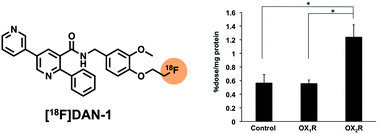Synthesis and characterization of a novel 18F-labeled 2,5-diarylnicotinamide derivative targeting orexin 2 receptor†
Abstract
Orexin 2 receptor (OX2R) is thought to play an important role in the arousal-promoting function, but its distribution and function in the pathophysiology of orexin-mediated disorders remains to be fully elucidated. In the present study, we synthesized and characterized a novel 18F-labeled 2,5-diarylnicotinamide (DAN) derivative as a potential positron emission tomography (PET) probe for in vivo imaging of OX2R. In in vitro binding experiments, [18F]DAN-1 selectively bound to OX2R. In a biodistribution study using normal mice, [18F]DAN-1 displayed moderate brain uptake (2.10% ID per g at 10 min post-injection). In addition, the radioactivity in the mouse brain at 30 min post-injection was significantly decreased by co-injection with nonradioactive DAN-1, but high nonspecific binding was observed. These results suggested that further structural modifications of [18F]DAN-1 are needed to use it for imaging OX2R in the brain.



 Please wait while we load your content...
Please wait while we load your content...